State of Misinformation 2021 — Southeast Asia
The way we get our news is changing, rapidly.
Once there were only a few sources of authority when it came to getting information about the world, and those sources were authoritative, neutral, and credible. Today, there are thousands of places to get information, both online and offline — and different sources may be more credible than others. Information is even being created for the sole purpose of misleading the public. It’s a world full of fake news.
Fake news isn’t just limited to made-up stories. It also includes Photoshopped images, videos placed in a different context, fake websites made to look like credible sources, and more. This type of content is created to be eye-catching and highly shareable, and can go viral before anyone realizes it’s not a reflection of reality.
Unfortunately, this type of misinformation can not only cause people to doubt what they see online. If the misinformation is believed, it can cause distrust in each other, in government, and in societal institutions.
Is fake news a problem that is simply the sacrifice for having a world in which most of our lives take place online, in unregulated and often anonymous spaces, where anyone can post anything? Or is fake news at the point where it’s forcing us to put into place solutions around transparency and accountability?
We wanted to answer these questions and to better understand the state of fake news and online trust today.
Methodology
Between April 2 and 6, 2021, we surveyed 1250 individuals from Southeast Asia to assess their everyday encounters with fake news, where they find it most online, how it’s impacted their behaviors, and how much of a threat they believe it to be.
Our respondents mostly reside in Singapore (72%), but also represent the following countries: Philippines (20.6%), Indonesia (3.4%), Malaysia (2.9%), Thailand (.5%), Vietnam (.3%), Cambodia (.2%), Brunei (.1%), and Laos (.1%).

52.2% of our respondents are female and 47.8% are male. The largest respondent group in age falls between 25 and 34 (32.2%). Otherwise, 3.3% are 16 or 17 years old, 26% are ages 18 through 24, 24.2% are ages 35 through 44, 10.1% are ages 45 through 54, and 4.2% are above the age of 54.


Key Findings
Here are a few of the insights we discovered from our survey:
Over half are getting their news from social media. 54% turn to social media first for news, and are replacing TV and print newspapers with Facebook, Twitter, and YouTube.
People are overconfident in their ability to spot fake news. 90% of respondents were either very or somewhat confident they could spot fake news. Yet 37% have unknowingly shared false or misleading content online.
They’re mostly seeing false information circulating online, as well as manipulated content and imposter news sites. Of the different types of fake news in circulation, untrue information, doctored photos and video, and news sites pretending to be credible sources are showing up the most in their news feeds.
Fake news is causing more people to fact-check. 46% say they are now fact-checking information more, and when encountering untrustworthy websites, 64% seek to confirm the information from another source.
67% believe fake news impacted their elections, and fake news is as much of a threat as terrorism. While respondents see data theft and climate change as more of a threat to society, they do believe that fake news and terrorism are equal threats to society. Over two-thirds believe that fake news impacted elections in their country.
Governments and regulators should solve the problem of fake news. Respondents believe that individuals who create and spread fake news are responsible for the problem, and that the government and regulators should step in to fix it.
They trust traditional media sources and search engines more than social media. Traditional and broadcast media are more trustworthy than social media, as are search engines. Yet social media is quickly becoming the first stop for news and information.
Increasing transparency is a way to solve the fake news problem. Respondents said their trust in online content would increase if they could see who the organization is behind the content, who the author is and their credentials, and a history of changes made to the content.
Part 1: Encounters with Fake News and Misinformation Online
While online environments are where we mostly conduct our lives today, the nature of online platforms poses a challenge: What information is truthful, and what has been deliberately created to mislead or deceive? The bigger question is not whether fake news is out there, it’s if people are readily seeing it when it does appear on their news feed or in search results — or if it’s doing the job it was intended to do and being confused for the real thing.

They’re getting their news from social media first
First, we wanted to know where our respondents are mainly getting their news. Over half (54.2%) say social media is where they go first for news today, and as we’ll see later, Facebook is their most trusted social media site. 14.5% say they go directly to an online media website for their news. 12.7% get their news primarily from television, and 11.7% get their news directly from YouTube. Other sources include print newspapers (4.5%), radio (1.4%), and podcasts (.9%).
Social media replaced television and print news sources
With the rise of online platforms, and with online spaces changing so rapidly, has their preferred source of news always been the same, or has it changed? One year ago, only 39.6% of respondents were getting their news from social media — still the majority, but 14.6% less than today. Additionally, only 6.7% were getting their news from YouTube, 5% less than this year. A greater percentage (25.2%) were getting their news from television last year, which fell 12.5% this year. Additionally, 12.5% said print newspapers were their primary source of news one year ago, which also fell 8% this year.
This shift shows that people are increasingly replacing more traditional news sources like TV and print newspapers with social media sources and YouTube.
Additionally, last year respondents were getting their news primarily from online media websites (11.3%), radio (3.5%), and podcasts (1%).

89.5% are either very or somewhat confident they can spot fake news
Since our respondents are mostly going to social media for their news, how confident were they in their ability to spot misinformation online when they see it? 26% replied that they were very confident they could identify fake or misleading news online when it showed up in their news feed. The majority of respondents (63.5%) believed that they would be somewhat confident they could spot it. 10.5% weren’t confident at all that they could spot it.
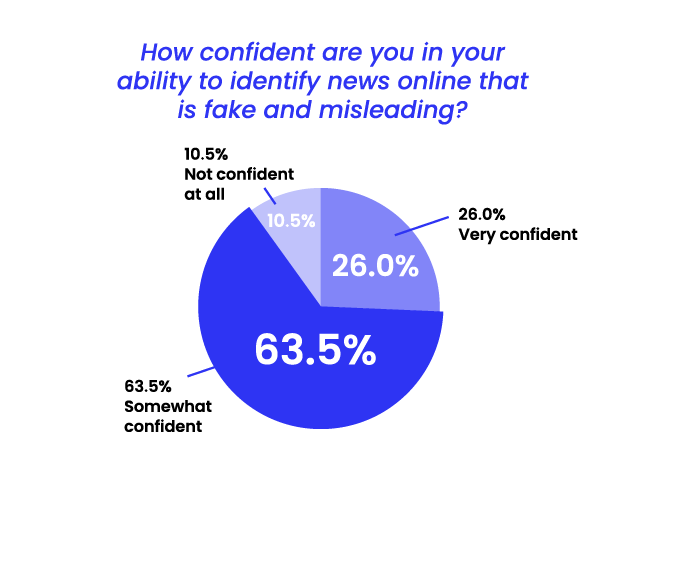
Yet 37% have shared misleading content on social media accidentally
Fake news is deliberately designed to appear real, so that users don’t know what they’re sharing is disinformation. We wanted to know if our respondents have ever shared content on social media that they later found out was false, misleading, or fake news — despite being confident that they could recognize it?
37% of our respondents admitted they had accidentally shared something they later found to be fake, which means that they might be overconfident in their ability to recognize fake news after all. However, about the same amount (37.8%) believe that they have not shared anything to be fake or misleading online (then again, how would they know?).
20.5% replied that they didn’t share misleading information because they don’t share anything online, and 4.7% weren’t sure if they had or hadn’t.

29% believe they rarely see fake news on social media
Despite having mistakenly shared misinformation, 29% of our respondents believe that they very rarely see fake news on social media platforms, and 16.8% believe they’re only seeing one fake news post per week. 31.1% believe they’re seeing fake news one to five times per week — around one post or less per day. Is that truly how many fake news posts are out there? Or are truly deceptive posts going undetected, and our respondents are just noting what’s obviously fake?
In contrast, 6.7% believe they see fake news six to ten times per week, 2.2% see fake news eleven to twenty times per week, and 3.4% believe they see fake news over twenty times per week.

35.9% believe they rarely see fake news on search engines — and trust their results more
When asked the frequency of seeing fake news on search engines, our respondents are more confident they’re seeing less of it than on social media. 35.9% say they very rarely see misleading information returned by search engines. 17.4% believe they see it only one time per week, and 24.7% believe they see it only one to five times per week. This could be due to the fact that search engines are considered more trustworthy, and return results that readily show the source of the information.
6.9% believe they see fake news six to ten times per week, 1.5% see fake news eleven to twenty times per week, and 2.7% believe they see fake news over twenty times per week — also fewer numbers than social media.

They’re mostly seeing false information circulating online, as well as manipulated content and imposter news sites
According to The Columbia Journalism Review, there are six types of fake news: authentic material used in the wrong context, imposter news sites designed to look like brands we already know, fake news sites, fake information, manipulated content, and parody content. Which type of fake news did our respondents believe they were seeing the most in their interactions online?
False information (30.8%): They reported that they’re mostly seeing false information, which are untrue facts, statements, or claims presented in highly-shareable formats like images, graphics, and videos.
Manipulated content (18.8%): Next, they’re seeing manipulated content, which are images and videos that are edited or Photoshopped to present a situation or reality that never happened.
Imposter news sites (17.7%): They’re also seeing imposter news sites that design themselves to look like trusted news sites — from logos to URLs that are similar to the real link — in order to fool people into believing they’re sharing trusted information.
They’re also seeing authentic material used in the wrong content (14.8%), fake news sites (14.6%), and parody content (3.3%).

Summary
As more people rely on social media for their source of news and information, they’re going to have to be more vigilant around the presence of fake news and misleading content. Our respondents believed they were very rarely seeing fake news posts, and 89.5% were either very or somewhat confident they could spot fake news. However, 37% of our respondents also admitted to having shared fake or misleading content that they didn’t realize was fake at the time. This simply means that those creating fake news are succeeding.
Part 2: Trust on the Internet
Fake news is untrustworthy because it contains misinformation, but is typically also untrustworthy because it comes from a questionable organization or a questionable author (or has no author), or has been shared and changed so many times the original story is no longer traceable. But what makes content online trustworthy? This is what we wanted to find out next: What type of online content is more trustworthy than others?
Government, medical, legal, and financial sites are the most trustworthy
When it comes to trusting information online, we wanted to know what kind of sites our respondents consider more trustworthy than others. Government websites ranked the highest for trustworthiness (58.1%), followed by medical websites like hospital and pharmacy sites at 40.6%. Legal websites ranked next (39%), followed by financial websites like bank and investment firm sites (27%). These high-ranking sites align with organizations and professions that have a high level of regulation, or that require a level of training and certification, and therefore offer authority and credibility.
eCommerce websites ranked much lowered at 14.4%, and the general internet ranked last at 13%. Lack of trust here could stem from there being a lack of regulation, the understanding that they might be biased or have sales pitches, or that there’s no way to tell who is creating the information.

Local news and national news are both trusted
In our next set of questions, we wanted our respondents to evaluate between sources of information, and to decide what sources they trust the most when compared side-by-side.
First, our respondents were nearly split on who delivers the most accurate news and information: local news (51.9%) or national news (48.1%). This means that our respondents don’t see a difference in credibility and quality between national and local sources.

They trust traditional media sources more than social media
However, our respondents trusted traditional media like TV, newspapers, and online news (58.3%) more than social media (41.7%) to provide more accurate news — yet social media wasn’t that far behind. We already saw above that social media has already replaced a number of traditional media sources as the primary source of news, so it may only be another year or two before social media overtakes traditional media.

They trust search engines over social media for more accurate news and information
As we saw earlier, they also trust search engines like Google, Bing, and Yahoo (58.1%) to provide more accurate information than social media (41.9%), most likely given that search engines show where the content is coming from, and rank it.

Broadcast media is much more trustworthy than online media
Broadcast media like television or radio is believed to be significantly more trustworthy (69.5%) than online media (30.5%).
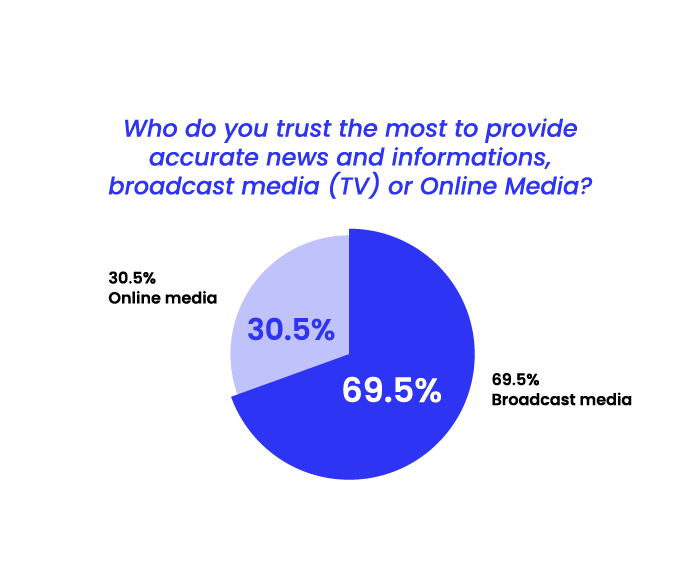
Facebook provides more accurate information than Twitter
In evaluating specific social media sites, our respondents found that Facebook (64%) provides more accurate news and information than Twitter (36%).

Google is far more trustworthy than Facebook
Facebook might be trusted, but it couldn’t compare (24.3%) to the trustworthiness of Google (75.7%).
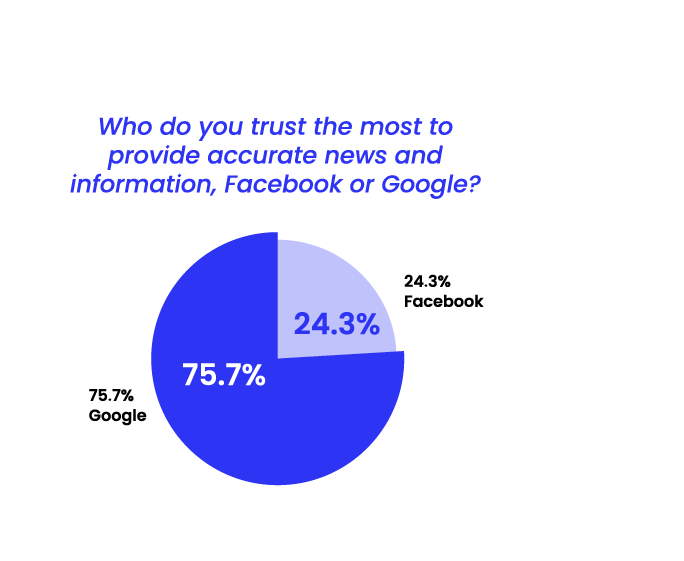
Facebook and YouTube are the most trusted social media platforms
In looking closer at different social media platforms, which did our respondents associate the most with being trustworthy and accurate?
Facebook came in first with 34.1% labelling it as the most trustworthy social media site. YouTube came in second at 15%, which aligns with what we found earlier in regards to using YouTube as a primary source of news. LinkedIn, the professional networking site, came in third at 13.1%, with Twitter close behind at 12.7%.
Other sites that ranked as less credible are Instagram (8.5%), WhatsApp (4.7%), Reddit (5.8%), Quora (3.3%), TikTok (2.5%), and Snapchat (.2%).

Facebook and TikTok are the least trust social media platforms
What about social media platforms that our respondents associate the least with trust? Facebook, which was the most trusted platform, is also the least trusted platform, according to 33.6% of respondents. In fact, many respondents who had ranked Facebook as the most trustworthy also ranked it as the least trustworthy, demonstrating that they have an awareness of how both true and fake content can show up on the platform.
This is followed closely by TikTok at 21.4% and WhatsApp at 10.5%.
Other social media platforms rank as such: Twitter (7.7%), YouTube (6.4%), Snapchat (5.2%), Reddit (4.2%), Instagram (4.1%), Quora (4%), LinkedIn (3%).
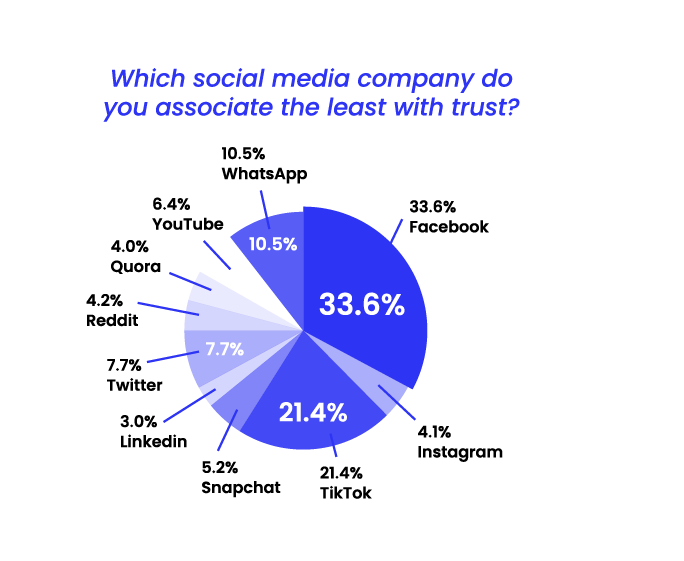
Summary
We now have a much better sense of understanding what sources our respondents find most trustworthy: Websites backed by authoritative, professional organizations or entities are considered more trustworthy, as well as broadcast media and traditional media sources. However, online sources of information are gaining on those traditional sources. When it comes to social media, Facebook is held favorably when it comes to trust overall, but is also a kind of microcosm of the internet, with both true and fake content on the site. Still, when it comes to online sources, search engines in general, and Google in particular, are the most reliable.
Part 3: The Impact of Fake News
Our respondents reported that they weren’t seeing fake news that much online, and that they were confident they would be able to determine if what they were seeing was fake. Does that mean that fake news and the spread of misinformation was not impacting their lives at all? What we found was that, in fact, fake news does have an impact, not just on individual lives, but on society as a whole.

67.2% have been impacted by fake news
With the prevalence of fake news and misinformation online, we wanted to know if fake news has impacted their behaviors. 67.2% replied that yes, misleading information online has indeed impacted their decisions. 21% replied that no, it did not, and 11.8% weren’t sure if it had.
45.9% are now fact-checking information more because of fake news
Next, we wanted to know more about that impact. For the majority of our respondents (45.9%), encountering fake news has prompted them to check facts more thoroughly when they see news or information online — in other words, to respond more proactively in discovering the truth.
For others, the rise of fake news means avoidance. 10.9% replied that fake news has caused them to stop getting news from a specific news site. 10.6% have reduced the amount of news they consume overall, and 7.6% have reduced their time on social media.
Nearly a quarter of respondents (24%), however, believe that fake news has had no personal impact on them.

64.4% check misleading information they see before proceeding on an untrustworthy website
When they visit websites they don’t trust, how do they react to information they see there? For the majority of our respondents (64.4%), they react by seeking additional information from other sources to corroborate the information before moving forward. This signals a fair amount of awareness when it comes to questionable information.
17% decide to delay their actions or decisions if they encounter misleading information. 9.1% continue using the information or making the purchase, but admit feeling nervous about doing so. 4.1% mitigate the risk by using a fake identity on the website, and 3.4% continue without any hesitation.

Fake news and terrorism are considered equal threats to society
We wanted to get a sense of how detrimental our respondents felt fake news is to society by asking them to compare some large-scale societal threats.
First, when asked which is the bigger risk to society, our respondents were nearly split between fake news (50.9%) and terrorism (49.1%) being the bigger threat — yet fake news edges out by 1.8%.

Data theft is more of a threat than fake news
Our respondents actually see data theft as being more of a pertinent threat to society (62.9%) than fake news (37.1%).

Climate change is more of a threat than fake news
Our respondents also saw climate change as being more of a threat to society (62%) than fake news (38%).

67.4% believe fake news impacted their elections
Finally, we wanted to know the impact our respondents believed fake news had on influencing elections in their country. Two-thirds of our respondents (67.4%) were convinced that the spread of fake and misleading information indeed had an impact on their elections. Another 16.9% were unsure if they had or not. Only 15.7% replied that they didn’t think fake news impacted their elections.

Summary
While some of our respondents might have stated that they didn’t believe fake news had an impact on their lives, we did find that the abundance of fake news has prompted some healthy responses: 45.9% are now fact-checking more when they come across pieces of content, and 64.4% check information they may see on an untrustworthy website. This proactive approach to seeking out the truth and becoming a more savvy online user is better than avoiding sites altogether, or taking what’s presented at face value.
Additionally, while our respondents didn’t see fake news to be as big of a threat as data theft or climate change, they saw it as equal in threat as terrorism, and over two-thirds believe that fake news impacted elections, which can have far-reaching massive society impacts themselves.
Now that we know the extent of the threat — is it solvable?
Part 4: Solving the Fake News Problem
Fake news is a massive challenge, from how it undercuts trust in online spaces to how it impacts individuals’ decision-making to how it can influence society. Can that big of a challenge be solved? And by whom? Or is fake news just an accepted part of online life going forward?
Individuals who create and spread fake news are responsible for the problem
When it comes to who’s responsible for fake news’s presence and proliferation online, 42.6% blame individuals who knowingly post intentionally misleading content for being the cause of the problems of fake news. 23.2% assign responsibility to tech companies like Facebook and Google, possibly for allowing content to be posted and spread on their platforms, and 20.7% blame news media. Only 13.4% see the government and regulators as responsible for the spread.

Governments and regulators should solve the problem of fake news
Who should solve fake news? The majority of our respondents (34.3%) believe that the government and regulators will be the ones to solve this problem — and we had already seen previously that government sites are the most trusted, reflecting the high confidence.
Three other entities came in nearly even as also being options for solving this problem: traditional news media (18.9%), fact-checking organizations (16.6%), and big tech companies like Facebook, Google, and Twitter (15.6%).
A small number believed that individuals (9%), open-source technology (3.9%), or small start-ups (.5%) could solve it. Responses in “Other” included that multiple entities should work together to come up with a solution.
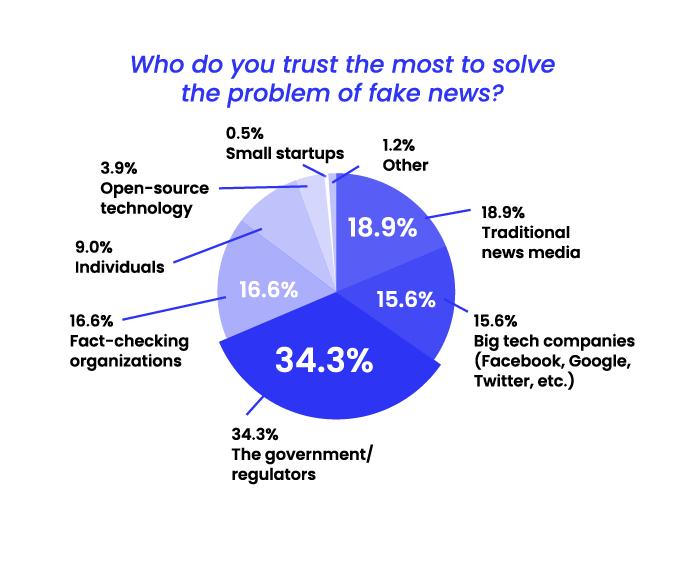
68% believe government and regulators need to step in to solve the problem
After what we found above, we asked respondents to choose between government and media. 68% believed that the government and regulators will need to step in to solve the problem. Only 24.4% believed that media and tech companies — who own the online spaces where fake news is typically spread — need to solve this without the government getting involved.

Government and regulators have been doing the best job at addressing fake news
When it comes to addressing the issue of fake news so far, is anyone doing a good job of it? Again, our respondents were more positive about how the government and regulators (49.3%) have been able to address the spread of misinformation over the past year. Fewer believed that major news media was addressing the issue (33.3%), and there was less confidence in tech companies to do so as well (28.8%).

64.3% support regulation to make creating and sharing fake news a crime
Would our respondents support regulation that made it a crime to create and share fake news? 64.3% said yes, they would, possibly because they see the kind of threat fake news is and the kind of damage it can do. Only 22% said they would not, and 13.7% were unsure if they would.

Increasing trust in content means knowing the author or organization behind it, and how it’s changed over time
Knowing that many of our respondents will now fact-check when faced with misinformation, we wanted to know what measures could be taken to increase their trust in content online. For 49.8%, knowing exactly what organization and author was behind the content would increase their trust that the content was reliable and truthful. 35.2% replied that being able to see which changes had been made over time to the content, so they could see how it was updated or if it was incorrectly altered, would be helpful. 13% wanted to be able to easily research the reputation of the author.

Increased visibility into content creation and author reputation increases trust
Similarly, when asked which scenarios would be the most impactful in terms of increasing trust, our respondents favored knowing the author or organization behind the content (45.5%), then being able to easily research the author’s reputation (41.1%), followed by seeing exactly what changes had been made over time (35.8%).

57.3% are in favor of search engines limiting unauthorized or unverified content
After learning above that our respondents trust search engines to deliver more credible information, we wanted to know how they would feel about search engines limiting content that is not connected to an organization or author in their search returns. Over half our respondents (57.3%) were in favor of that action. 25.4% were not in favor, and 17.3% weren’t sure of an answer.

72.6% believe all content online should show a history of changes
Returning to the idea of being able to see a record of changes made to a piece of content, we wanted to know if our respondents supported a push to have all content published online show a history of changes made since publication. 72.6% were in favor of that measure. Only 15.8% replied that they were not in favor, and 11.6% weren’t sure.

Only 37.4% believe fake news will decrease over the next five years
When it comes to what the state of fake news will be in five years, 37.4% of our respondents had a positive outlook, and believed that fake news would improve. Yet 27.1% saw it as largely remaining the same, with no changes in either direction. A quarter of respondents (25%) believed that fake news will actually get worse over the next five years, with more impact on society. 10.5% weren’t sure what the state of fake news would be.

47.8% do believe the problem of fake news can be solved
Fortunately, almost half of our respondents (47.8%) do believe that the problem of fake news can be solved, either through government intervention or increased methods of transparency online. Still, 35.4% believe that the problem of fake news cannot be solved, and 16.8% weren’t sure if it could.
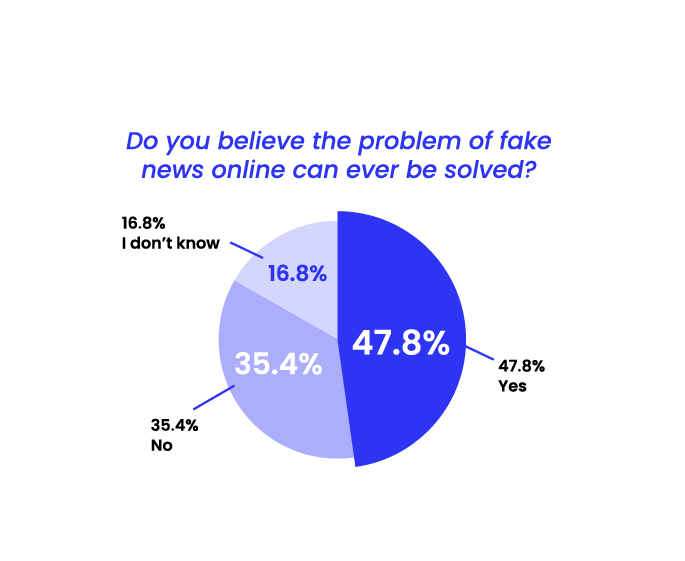
Summary
When it comes to who created the problem of fake news, our respondents believe that individuals who deliberately create and share it are responsible, as well as tech companies and news media. But when it comes to fixing the problem, our respondents believe that the best course of action is to have the government and regulators step in.
Our respondents also believe that increased transparency and accountability online can bring increased trust as well: Provide the organization behind the content, provide the author and their credentials, show a history of changes made to the content, have search engines limit or restrict content that doesn’t provide information about its authorship, and require each piece of content published online to show a history of its changes or modifications.
Despite the challenges, a fair number of our respondents do believe the problem of fake news can be solved.
Conclusion
Fake news is a problem, and may be a more deceptive one than we realize. It’s made us wary of going about our lives online, and has impacted everything from individual decisions all the way up to elections. It’s something that can no longer go unchecked.
What we discovered from our respondents is that a solution can be found in transparency. When faced with misleading information or untrustworthy sites, the majority of our respondents wanted to fact-check and seek out the truth about the content. They also believe that making available information around authorship, the organization behind the content, and the changes made to the content will give readers the ability to make better decisions on the credibility of that content. Having search engines limit unverifiable content, and having governments and regulators take part in ensuring the safety of online spaces can also help as well.
The problem of fake news isn’t impossible to solve. We just have to actively tackle it with transparency and accountability, and with a goal towards making the internet a more reliable place for all.